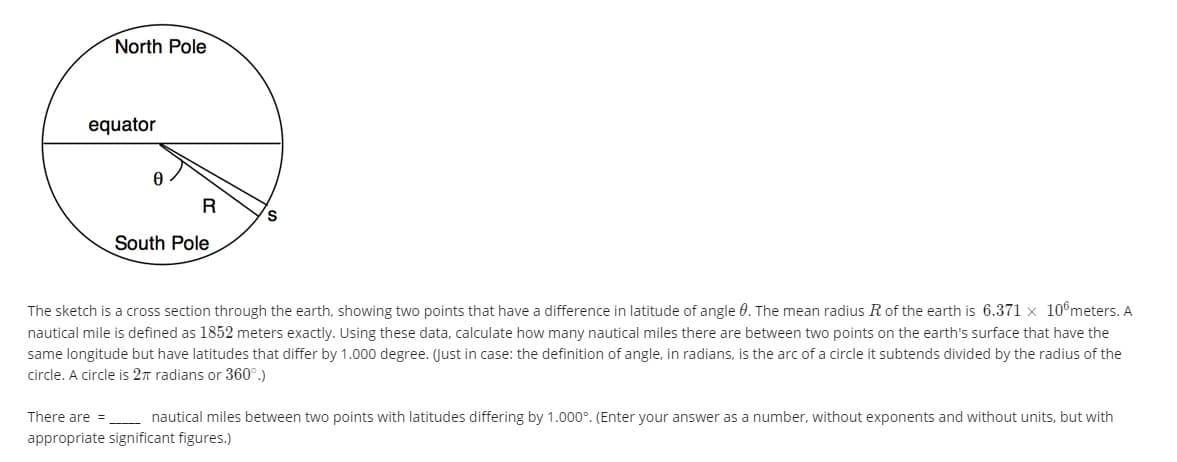The sketch is a cross section through the earth, showing two points that have a difference in latitude of angle 0. The mean radius R of the earth is 6.371 x 10°meters. A nautical mile is defined as 1852 meters exactly. Using these data, calculate how many nautical miles there are between two points on the earth's surface that have the same longitude but have latitudes that differ by 1.000 degree. (Just in case: the definition of angle, in radians, is the arc of a circle it subtends divided by the radius of the circle. A circle is 27 radians or 360°.) There are = nautical miles between two points with latitudes differing by 1.000°. (Enter your answer as a number, without exponents and without units, but with appropriate significant figures.)
The sketch is a cross section through the earth, showing two points that have a difference in latitude of angle 0. The mean radius R of the earth is 6.371 x 10°meters. A nautical mile is defined as 1852 meters exactly. Using these data, calculate how many nautical miles there are between two points on the earth's surface that have the same longitude but have latitudes that differ by 1.000 degree. (Just in case: the definition of angle, in radians, is the arc of a circle it subtends divided by the radius of the circle. A circle is 27 radians or 360°.) There are = nautical miles between two points with latitudes differing by 1.000°. (Enter your answer as a number, without exponents and without units, but with appropriate significant figures.)
University Physics Volume 1
18th Edition
ISBN:9781938168277
Author:William Moebs, Samuel J. Ling, Jeff Sanny
Publisher:William Moebs, Samuel J. Ling, Jeff Sanny
Chapter2: Vectors
Section: Chapter Questions
Problem 79AP: A skater glides along a circular path of radius 5.00 m in clockwise direction. ‘When he coasts...
Related questions
Concept explainers
Question

Transcribed Image Text:North Pole
equator
South Pole
The sketch is a cross section through the earth, showing two points that have a difference in latitude of angle 0. The mean radius R of the earth is 6.371 x 10°meters. A
nautical mile is defined as 1852 meters exactly. Using these data, calculate how many nautical miles there are between two points on the earth's surface that have the
same longitude but have latitudes that differ by 1.000 degree. (Just in case: the definition of angle, in radians, is the arc of a circle it subtends divided by the radius of the
circle. A circle is 2n radians or 360°.)
There are =
nautical miles between two points with latitudes differing by 1.000°. (Enter your answer as a number, without exponents and without units, but with
appropriate significant figures.)
Expert Solution
This question has been solved!
Explore an expertly crafted, step-by-step solution for a thorough understanding of key concepts.
This is a popular solution!
Trending now
This is a popular solution!
Step by step
Solved in 2 steps with 2 images

Knowledge Booster
Learn more about
Need a deep-dive on the concept behind this application? Look no further. Learn more about this topic, physics and related others by exploring similar questions and additional content below.Recommended textbooks for you

University Physics Volume 1
Physics
ISBN:
9781938168277
Author:
William Moebs, Samuel J. Ling, Jeff Sanny
Publisher:
OpenStax - Rice University

College Physics
Physics
ISBN:
9781305952300
Author:
Raymond A. Serway, Chris Vuille
Publisher:
Cengage Learning

College Physics
Physics
ISBN:
9781285737027
Author:
Raymond A. Serway, Chris Vuille
Publisher:
Cengage Learning

University Physics Volume 1
Physics
ISBN:
9781938168277
Author:
William Moebs, Samuel J. Ling, Jeff Sanny
Publisher:
OpenStax - Rice University

College Physics
Physics
ISBN:
9781305952300
Author:
Raymond A. Serway, Chris Vuille
Publisher:
Cengage Learning

College Physics
Physics
ISBN:
9781285737027
Author:
Raymond A. Serway, Chris Vuille
Publisher:
Cengage Learning

Principles of Physics: A Calculus-Based Text
Physics
ISBN:
9781133104261
Author:
Raymond A. Serway, John W. Jewett
Publisher:
Cengage Learning

Physics for Scientists and Engineers
Physics
ISBN:
9781337553278
Author:
Raymond A. Serway, John W. Jewett
Publisher:
Cengage Learning

Physics for Scientists and Engineers with Modern …
Physics
ISBN:
9781337553292
Author:
Raymond A. Serway, John W. Jewett
Publisher:
Cengage Learning